It is not uncommon for ordinary people to want to remove gilding from jewelry or other items made of silverThis can be dictated by the desire for a classic silver piece or the removal of a worn layer of gilding. This can be dictated by the desire for classic silver jewelry or to remove a layer of worn gilding. There are many safe ways to remove the gilding, all of which will be presented here.
Jewelry made of gilded silver. Why and what kind of gilding is applied to silver jewelry
Jewelry as well as works of art are never made of pure precious metal (which are regulated by the periodic system of elements), it is impossible because of the specificity of the metal, as at 0.1% they include its own oxide - a product of oxidation by atmospheric air.
First of all, the demand for the use of bimetallic alloys for the manufacture of jewelry is due to the characteristics of metals. GoldThe metals gold and silver are very soft metals that are easily deformed. To reduce this, alloying (strengthening) metals are added to gold or silver. For example, copper is most commonly used for silver and the same is used for gold. silver.
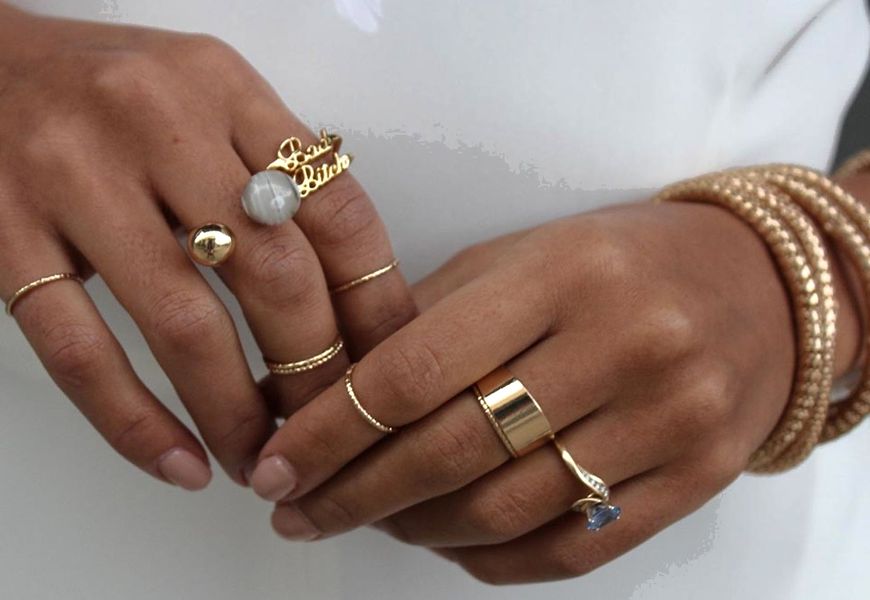
A special assay is used to reflect the quantitative content of the precious metal in relation to the alloying metal. This is a number embossed on a special band and placed in a inconspicuous place so as not to spoil the jewelry's aesthetic appearance.
The Russian jewelry industry uses a metric calculation of quantitative metal content, which is calculated in milligrams.
Demand for gilded items. Lifetime of gilded jewelry
Pure gold jewelry is very expensive, which is why it is not available to everyone. An excellent alternative is presentable, high-quality jewelry made of silver with gilding. If you do not look closely, this jewelry could be mistaken for gold. Moreover, they are made of silver, which is also a noble and precious metal.
Counterfeit detection can only be done by undercutting or using chemicals. But this requires special conditions.
Gilded items have a lifespan that is related to the wear and tear of the gilding layer. It is also referred to as the gold leaf layer. The specifics of durability depend on the composition and thickness of application. The most durable pieces of jewelry are those on which a layer of liquid alloy of gold and copper is sprayed. But if you replace the copper with cheaper tin, the durability of the coating will be less.
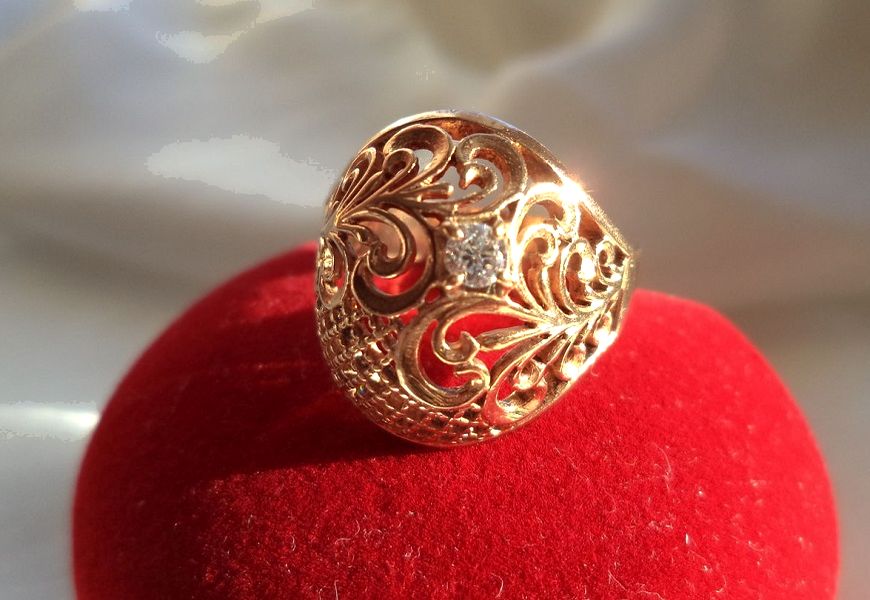
"Gold", which is so attractive to visitors to Turkey, contains a very small amount of yellow metal, respectively, has a low grade. But it is attractive to buyers because it is cheap. Longevity also leaves much to be desired, because gold has a large content of impurities of copper, tin or mercury.
How to handle gilded silver
Gilded Silver has a number of rules for use that are designed to increase its durability when worn:
- Before going to sleep, it is better to put the jewelry in a specially designated box or case.
- It is also better to remove jewelry when you do the work.
These rules are not related to abrasion or deformation, but to the formation of sweat during sleep and work. Sweat destroys gilding because of its specific composition and pH acidity.
- When working with aggressive cleaning agents, gilded jewelry is removed.
- If there is a risk of scratching or harsh action on gold-plated jewelry, it is best to refrain from wearing it. Otherwise, damage may occur.
In addition, very important questions are cleanings decorations, which are presented in many ways for the home. You can use solutions of ammonia, hydrogen peroxide, vinegar...or simple alcoholic beer. The main thing is to use the recommendations and follow the rules.
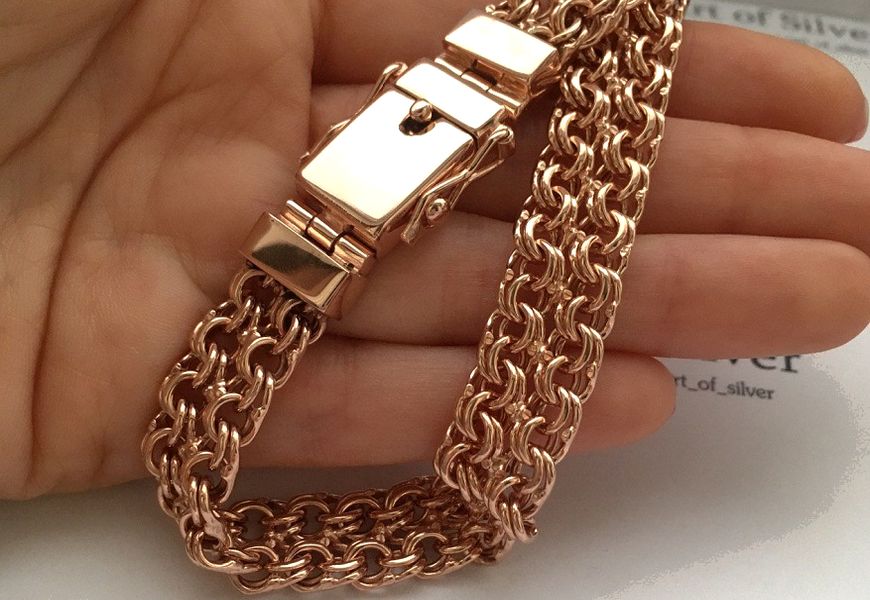
2 best ways - how and how to remove gilding from silver at home
The following ways are great for removing the gilding layer yourself at home. They are effectiveare completely safe if elementary safety rules are followed. But maximum attention should be paid to safety, because acids are used for implementation.
What you need to be safe:
- an even clean surface;
- rubber gloves;
- Soda on a plate for quick use to "remove" the acid that got on your skin;
- metal or glassware.

Acid method
- Sulfuric acid
Sulfuric acid is an ideal oxidizer, in its concentrated form it "destroys" any organics, also dissolves all metals except the noble ones. To use it you will need:
- 1 liter of sulfuric acid;
- 100 grams of liquid soap;
- 50 grams of liquid ammonia.
The uniqueness of H2SO4 lies in the ability to quickly dissolution metal oxides and light metal alloys. But in order to ensure penetration as well as fast dissolution it is necessary to add a binder, namely ammonia.
To remove the gilding it is necessary to place the jewelry (ring, earrings, pendant, chain) in a glass container with an ammonia-sulfur mixture for 10-12 hours. After the items are taken out, then covered with liquid soap, the gilding is removed with a brush.
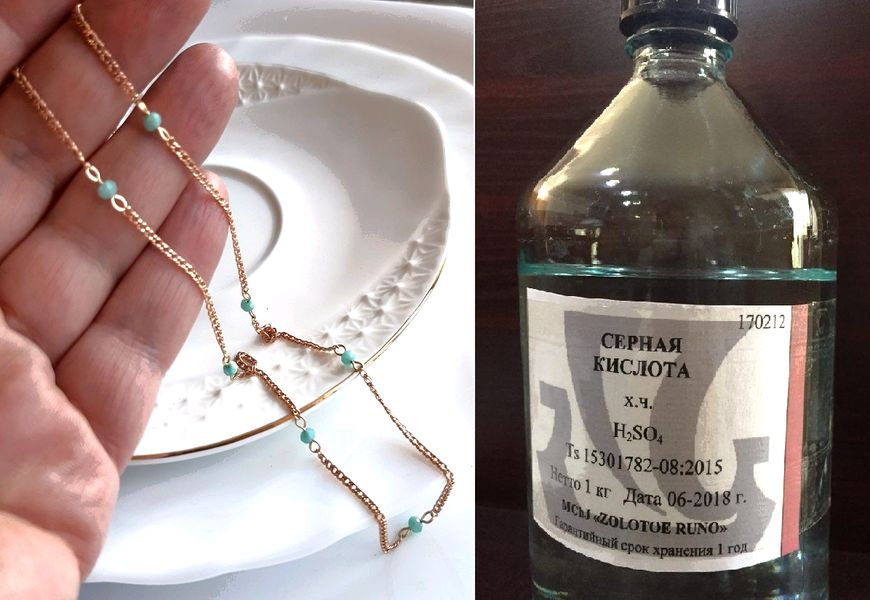
- Hydrochloric acid
Acid derived from a compound of hydrogen and chlorine is a mild solvent that is actively used in soldering to degrease metal surfaces.
To remove gilding, it can be used in its pure form by pouring up to 500 milliliters of acid into a container. Let's say it takes from 12 hours to 24 hours to remove gilding from a simple wedding ring, depending on the thickness of the gilding.
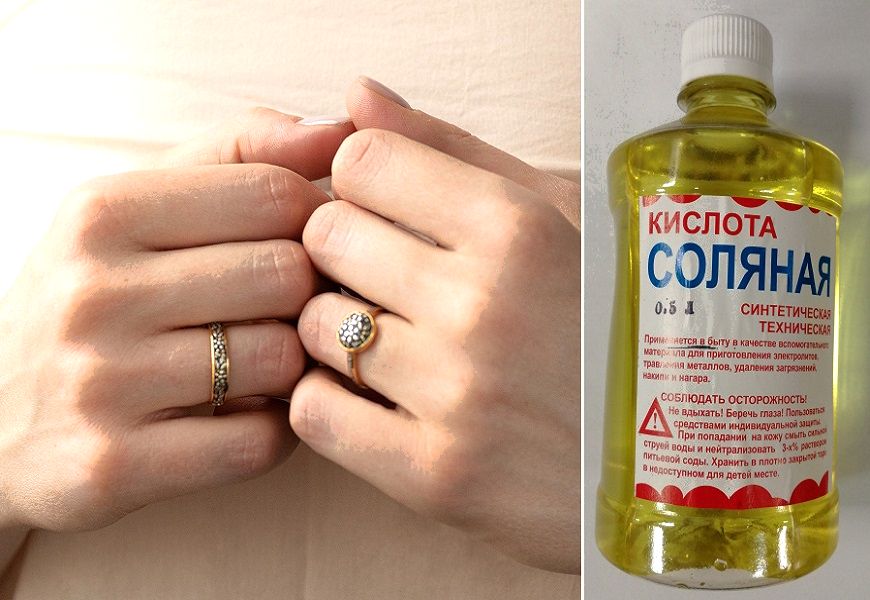
- Nitric acid
HNO3 is a single-base acid. It is a solvent, but it is extremely difficult to interact with metals, including not only noble elements, but alkaline earth elements as well. It can easily dissolve tin-based gilding, but if the gilding contains copper (red gold), the process will be slowed down.
How to speed up the dissolution process? To do this, you need to mix equal proportions of nitric acid, sulfuric acid and water. The water will create a catalyzing effect, i.e. speeding up the reaction. Mixing the two acids will cause the liquid to heat up and actively destroy the metal ions.
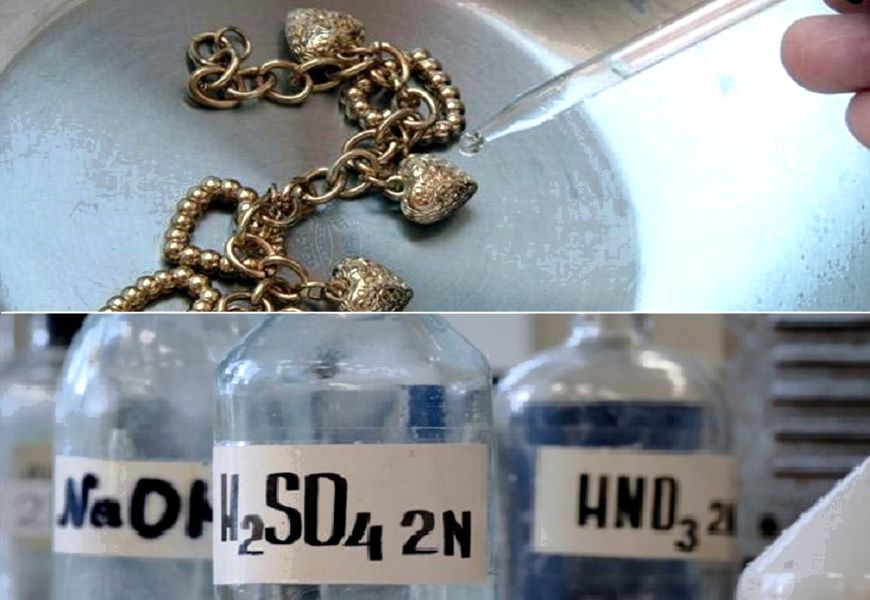
Removing with hydrogen peroxide
Hydrogen peroxide is an excellent solvent for organic elements in an unstable state. For example, hydrogen peroxide takes a long time to dissolve the skin, but quickly "absorbs" blood or blood suds.
To enhance the effect of hydrogen peroxide for a volume of 100 mg, we will need:
- sulfuric acid - 250 mg;
- Pharmacy sulfur, can be in the form of ointment - 50 mg.
Sulfuric acid is mixed with liquid peroxide.
Acid is poured in a thin stream into the peroxide, and vapor may form - it is the interaction of peroxide and salt - SO4.
To remove the gilding, the jewelry is placed in a metal or glass vessel with a solution for 10-12 hours. Afterwards, take it out carefully and rinse it with plenty of running water. If there is any gilding residue, the procedure is repeated.

Professional method
The professional method excludes the use of acids in their pure form. The professional method of removing gilding is the use of a specific electrolysis method.
Technology for removing gilding from coins
Electrolysis involves the following manipulations:
- 50 mg of potassium cyanide or an aqueous solution of sulfuric acid, the electrolyte, is poured into a glass vat.
- Two electrodes are placed inside the dish; professionals use metal plates for this - a negative anode and a positive cathode.
- The decoration is attached to a conductive cathode.
- A current of up to 15V is applied to the bath through the anode.
As the current passes through the electrolyte, the gilding will begin to dissolve, and the gold will begin to adsorb to the cathode. In other words, this is the removal of the gilding without dissolving the base.
Important!
Concentrated acids with mercury added can be used as a liquid, but the voltage should be increased to 35V.
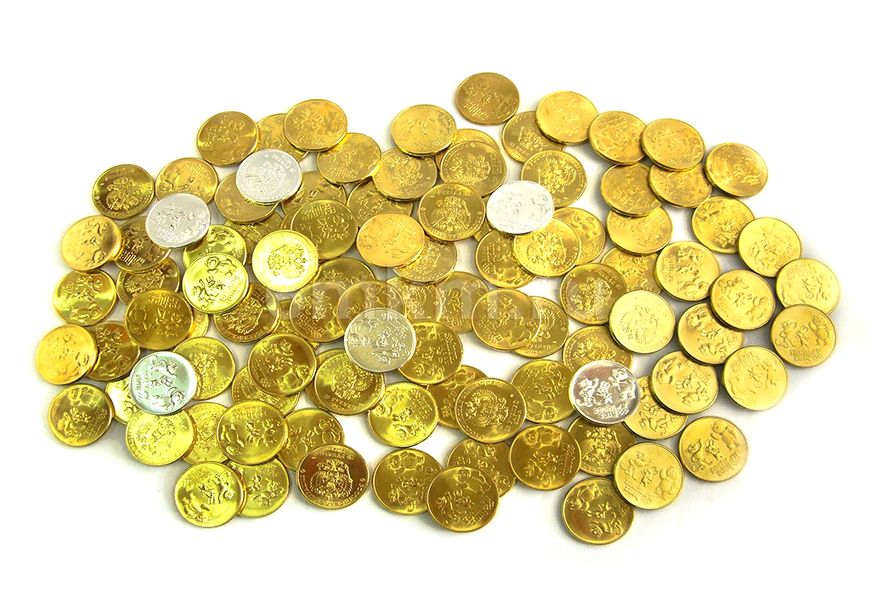
Remove gilding from silver in the workshop: price
| The withdrawal technique | Cost |
|---|---|
| Sulfuric acid applications | from 500 p. |
| Hydrochloric acid applications | from 700 p. |
| Electrocathode | from 1000 p. |
From gilding to mining gold from radio components
The method described above can also be used to "strip" gold from radio components such as TV or radio contacts. The use of gold in connectors and contacts is due to the low resistance of this metal. If you have the ability to buy up radio partsIf you are a goldsmith, you can make good money by "mining" gold out of them. But this would require the registration of a license for jewelry activities.
To apply you will need:
- 200 ml. sulfuric acid electrolyte;
- 100 ml of liquid ammonia.
The mixture of the two liquids is made in a metal (non-enameled) container. The radio element is placed inside, and the container itself is placed on the stove, on a low flame. Gradually the solution will boil and evaporate. Visually, the "gold" on the contact should darken, this means that the layer of gold coating dissolved acid. After that, the container is cooled, and water is poured in. The gold will settle to the bottom - you can catch it with a filter.
Video: How to easily remove gilding from silver with citric acid
Reviews
I decided to remove the gilding from my wedding ring. It's very expensive for me, even though it's not real gold. I made a solution of hydrogen peroxide and hydrochloric acid, which my husband gave me. I mixed it up, put the ring in, and waited a day. The next day I got a brand-new silver ring. It's a wonderful way to do it. Getting ready to clean the bracelet.


I decided to update the chain a little, a guest from Turkey. The gold chain was covered with patina. I used the hydrolysis method, I read on the Internet. The acid completely dissolved the gilding. For 20 years I thought the chain was gold. But at least the method works, I recommend it to anyone interested. By the way, my wife's earrings also turned out to be fake from Turkey.
My mother gave me an old silver ring that was covered in gold...well, gold-plated. It was beautiful, but the gilding had come off in places. I decided to make myself a simple silver ring. I found a lot of ways on the Internet and chose one - "remove gilding with citric acid and hydrogen peroxide". I did everything exactly and now I have a brand new silver ring.

Jeweler's Commentary

